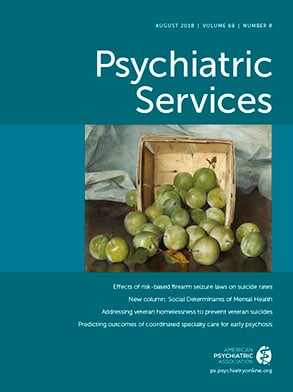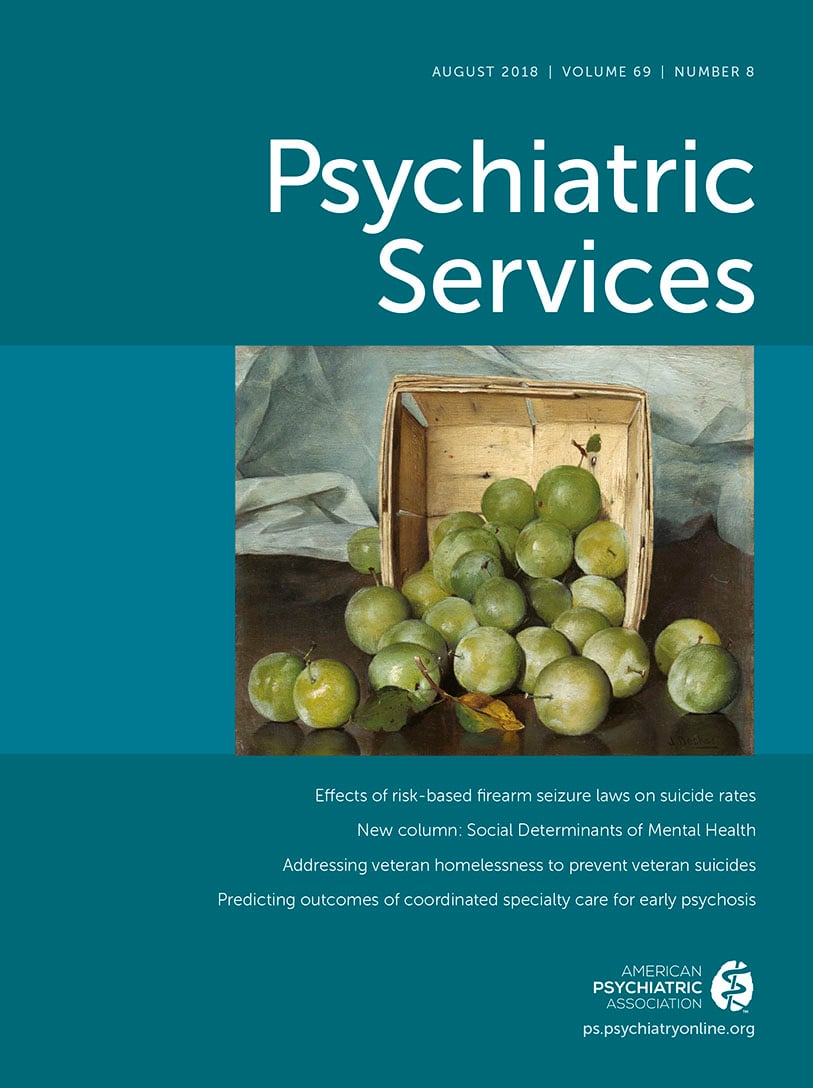In 2009, the U.S. Department of Veterans Affairs (VA) announced its goal to end veteran homelessness and subsequently spent over $10 billion over the next seven years on VA health care, housing, and social services for homeless veterans. Considerable progress has been made, with annual point-in-time counts indicating a 47% drop in veteran homelessness from 2009 to 2016 (
1). Under the new federal administration, administrative support and funding for VA homelessness programs may change, but how is not clear. For example, in late 2017, VA Secretary David Shulkin initiated plans to redirect millions of dollars for VA homelessness services to other VA services (
2) until a wave of protests from veteran advocates caused the secretary to retract these plans in December (
3). Moreover, under the new administration, the VA secretary has made veteran suicide the top clinical priority in the VA, which may shift focus away from veteran homelessness and toward veteran suicide.
Overlap Between Risk Factors for Veteran Homelessness and Suicide
While the focus on veteran suicide is an important one, the literature on homelessness and suicide among veterans suggests that they share similar risk factors. A systematic review found that major risk factors for veteran homelessness include substance abuse, mental illness, financial distress, and lack of social support (
4), which are also risk factors identified for suicide (
5). In particular, substance abuse is a major contributor to both homelessness and suicide, and this similarity in risk profiles connects them. In theory, addressing veteran homelessness can help prevent veteran suicides, and in practice, many VA homelessness services already work with homeless veterans with active suicidal ideation.
Fourteen of the 20 veterans who die by suicide daily are not engaged in VA care (
6), so one challenge of addressing veteran suicide is identifying and serving veterans not known to the VA. It is also worth mentioning that only a little over one-quarter of the veteran population has ever used VA health care (
7). The VA’s Recovery Engagement and Coordination for Health–Veterans Enhanced Treatment (REACH VET) program was created and implemented to identify, assess, and connect veterans found to be at risk of suicide (
8). A weakness of the program is that it is based on predictive analytics that use existing VA medical records; given that the majority of veterans who die by suicide do not use VA health care services, VA medical records may not exist or may contain little information. Greater outreach is needed, and the VA has initiated public service announcements, social media campaigns, and community partnerships to try to reach veterans outside the VA system. Importantly, one component of many VA homelessness services is providing community outreach to veterans not already engaged in VA care, and so presumably, these services are reaching segments of the high-risk veteran population that are being missed by the REACH VET program and other VA services.
Rates of Suicide Among Veterans Who Have Experienced Homelessness
Using data from 1,533 U.S. veterans drawn from wave 3 (July–August 2015) of the National Health and Resilience in Veterans Study (
9), a nationally representative study of all U.S. veterans, including those who do and do not use VA services, we examined rates of suicidal ideation and attempts among veterans with any history of homelessness. Poststratification weights were applied to the data based on demographic distributions from the most contemporaneous Current Population Survey to permit generalizability to the entire population of U.S. veterans. Homelessness was assessed with a question that asked, “In your entire adult life, have you ever been homeless (i.e., not had permanent housing and stayed in a shelter, transitional housing, outdoors, or some other unstable or non-permanent situation)?” This assessment question is consistent with the federal definition of homelessness.
Past suicide attempt was assessed with a question that asked, “In the past two years, have you tried to kill yourself?” Suicidal ideation was assessed with a two-part question adapted from the Patient Health Questionnaire–9 (PHQ-9 [
10]), which asked, “In the past 2 weeks, how often have you been bothered by thoughts that you might be better off dead or thoughts of hurting yourself in some way?” Suicidal ideation was operationalized as reporting these thoughts several days or more in the past two weeks. Lifetime suicidal ideation was assessed with a question adapted from the Mini-International Neuropsychiatric Interview (MINI [
11]) that asked participants, in reference to any two-week period during which they felt depressed anytime in their lifetime, “Did you repeatedly consider hurting yourself, feel suicidal, or wish that you were dead, or did you attempt suicide or plan a suicide?” In addition to assessments of suicidal ideation, several other validated measures of mental health and social functioning were administered [see
online supplement]. All participants provided informed consent, and study procedures were approved by the appropriate institutional review boards.
As shown in
Table 1, our results (weighted) revealed higher suicidality among veterans who had ever experienced homelessness compared with veterans who had not. Among veterans with any homelessness histories, rates of suicide attempts in a two-year period were more than 5.0 times higher (6.9% versus 1.2%), rates of two-week suicidal ideation were more than 2.5 times higher (19.8% versus 7.4%), and rates of lifetime suicidal ideation and attempts were 2.0 times higher (44.6% versus 17.0%).
Among veterans with a lifetime history of homelessness, we further compared those with and without any past suicidal ideation or attempts [online supplement]. Among medium to large effect size differences (d >.5 or Δ% >15%), we found that among veterans with histories of homelessness, those with past suicidal ideation or attempts were less educated, more likely to be white, and less likely to be married or with a partner compared with veterans with no past suicidal ideation or attempts. Veterans with ideation or attempts reported lower social support, and they scored higher on measures of posttraumatic stress disorder and depressive and anxiety symptoms and lower on measures of mental functioning.
Practice and Policy Implications
Our data on rates of suicidal ideation and attempts among veterans with homelessness histories are consistent with a systematic review of 19 previous studies (
12), which reported that suicide attempt rates among homeless veterans were 0%−6% in the prior month, 31%−32% in the past five years, and 15%−46% in the veterans’ lifetime. The rate of death by suicide was 81.0 per 100,000, which is much higher than that for veterans without a history of homelessness (35.8 per 100,000).
These high rates of suicidal ideation and attempts are also consistent with VA administrative records. Each VA medical center maintains a “high-risk flag” list for suicide, which consists of veterans who are deemed at serious risk and being actively monitored by suicide prevention coordinators. We examined one major VA medical center, the VA Connecticut Healthcare System, and found that 10% of veterans on the high-risk flag list for suicide were concurrently involved in a VA homelessness program. Across the VA New England Healthcare System, which includes eight VA medical centers and numerous VA community-based outpatient clinics, we found that 3.0% (144 of 4,741) of veterans currently involved in VA homelessness programs were on the high-risk flag list for suicide; this rate is more than 3 times the rate that can be estimated among general VA mental health service users in the New England region (492 with the high-risk flag among >50,000 veterans, or <1.0%).
These statistics are important because special purpose funds for VA homelessness services may be subject to change. A substantial portion of funding for the VA’s largest supportive housing program—the Housing and Urban Development–Veteran Affairs Supportive Housing program—may become “unfenced” and designated as general purpose funds, which may be reallocated for other VA services, such as the VA secretary’s priority on suicide prevention. However, providing comprehensive care, which includes homelessness services and various mental health and substance abuse treatment services, may ensure an effective treatment planning and delivery system to help stem the tide of suicides. Notably, many veterans who are high utilizers of VA psychiatric emergency rooms struggle with homelessness; one national study showed that homeless veterans had 4 times the odds of using emergency services compared with domiciled veterans (
13). Reductions in VA homelessness services may further complicate the VA’s ability to support the mental health and recovery of these high-risk high utilizers.
The VA’s current suicide prevention efforts are dedicated to identification, screening and monitoring, and crisis intervention and referral (
8,
14). In addition to using predictive analytics and high-risk models, the VA should aim to achieve a standard level of comprehensive care for all veterans. Suicide prevention coordinators need an array of VA programs to which to refer veterans, and some veterans will need the long-term, intensive, or community outreach services of VA homelessness staff. In that way, the VA’s evolving health care system is uniquely designed to address both homelessness and premature mortality among veterans, including suicide (
12).

